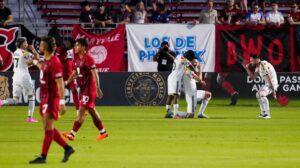Canadian soccer has a strong, passionate fanbase from coast to coast.
That fanbase is growing too — this much is obvious to anyone who has followed Canadian soccer on social media. For the new Canadian Premier League in particular, fans have created supporter groups, Facebook pages, podcasts, websites and every other type of soccer media or connective tool you could think of. To me, this is a great sign, as it will likely translate to long-term attention and support for the league, the teams, the players and the sport as a whole.
While the Canadian soccer fanbase is already strong for a league that just wrapped up its second season, there is still a bit of work to do, especially in the area of inclusivity.
Let me explain by starting on a personal note.
I play pickup soccer games at my local park regularly. As a 21-year-old from a tightly-knit South Winnipeg community, these little kick arounds and pickup matches have been a regular summer occurrence for as long as I can remember. I don’t see it stopping anytime soon.
There are all different kinds of people I play alongside at this park – yes, there are people in different age groups, but the most noticeable thing is that all these people come from all corners of the globe. I’ve met different people from at least 20 African countries. There are plenty of people with strong South and Central American roots as well, and not to mention an unbelievable amount of people from all corners of Asia, myself included.
To me, this is beautiful. While you might not see many people from these backgrounds playing at high levels in this country, due to a multitude of reasons, they are still talented on the pitch and have a deep love for soccer, or as many of them would rightfully call it, football.
Summertime Soccer
Back in the summer of 2018, it was announced that Winnipeg would be getting a founding team in the inaugural CanPL season, and this was a massive triumph for the local community. Finally, the people here who love soccer had a team to call their own, and a team to actively support. It was an exciting time for those involved with the game in the city and across the country.
However, I noticed something wrong eventually. I didn’t notice it right away, but eventually, it hit me like a truck. I’d sit in the stands at Investors Group Field, cheering on Valour FC during the 2019 CPL season. I’d often look around to my left, my right, and crane my neck behind me as well, and hardly any of the people I play with at the park, nor their friends, siblings, cousins or parents, were attending the matches.
Then I started to notice a few other things, such as how I was the only POC contributor at the Canadian soccer website I was previously writing for, or how people weren’t taking me seriously because I don’t come from a soccer-focused ethnic background.
In fact, there were truthfully a very small number of people at those matches who weren’t white. And yet, if you go check out any local park where people are playing pickup matches, it would be the opposite. This is a big problem, one that nobody seems to be discussing, and also one that is going to negatively affect our potential as a footballing nation if we don’t fix it.
So why is this the case and what can we do to fix it? I discussed this topic with League1 Ontario stars and Pakistani internationals, Navid and Adel Rahman:
Navid and Adel Rahman are a pair of Canadian/Pakistani brothers who have played professionally in Slovakia, and can currently be seen in League1 Ontario, a semi-pro division that has helped produce many of the Canadian Premier League’s current stars and coaches. The Rahman brothers are also currently the only full internationals in League1 Ontario, receiving call-ups to the Pakistani national team in recent years.
To learn a little bit more about Navid and Adel Rahman, I asked them a few simple questions.
What sort of player are you?
Navid: “I would say I’m more of a deep-lying playmaker. I normally play as a number 6, but sometimes as a number 8 as well. I like to take a lot of touches and pass the ball around, create quick one-touch moves, and I particularly enjoy playing in teams that press high.”
Adel: “We’re a bit similar but I’m more attacking minded. I look more for the final pass to play my teammates in on goal. A lot of through balls and combination play in front of goal. I also look to finish as well, obviously. We’re both very possession-oriented, technical players.”
How did you guys come onto the Pakistani national team radar?
Navid: “When we were playing in Slovakia, the Pakistani football technical director reached out to us and let us know we were on their radar. He reached out to us and wanted to bring us to the South Asian cup which was happening at that time. Unfortunately, we didn’t get our Pakistani passports created in time for that tournament, but we got them a few months later and then played for the first time in a friendly with Palestine, then a few unofficial friendlies, training camps, and finally a World Cup qualifier against Cambodia in June 2019. There haven’t been any games since then, because there’s a bit of a political issue with football in Pakistan.”
Some think former @League1Ontario player Emilio Estevez’s international experience with Taiwan is the reason he was signed by an Eredivisie side. #CanPL
Fun fact: There are 2 other players in L1O who are current internationals – Pakistani/Canadian brothers Navid & Adel Rahman! pic.twitter.com/3Wj9r4iiXV
— Mahith Gamage (@mahithgamage) May 29, 2020
Now, onto the meatier question:
How can we create a soccer impact within different Canadian minority communities, especially ones that aren’t soccer-focused such as the Pakistani one, to get them more involved with higher levels of the game?
Navid: “Well for a bit of context, when I was growing up there was no real pathway. When you turn 18 you either leave the country or stop playing, there aren’t many options other than that. It’s important for the kids now to realize that there is a realistic pathway for me not only to develop my game as a South Asian in Canada, but to play professionally here, and even represent a huge Asian country such as Pakistan on an international level. Obviously Pakistan is not a powerhouse, but playing internationally is a big accomplishment regardless, and kids here have the opportunity to do that now if they work hard and keep focus.”
Adel: “Having minorities playing at high levels is a big way to impact a community. From what I’ve seen amongst the people in our Pakistani community here in Canada, I’ve had parents come up to me with their kids who have now entered soccer, asking me what I did to get to my level, and how they can help their children do the same. If people see someone from their community has gotten to that level, it gives them more hope, more motivation, and a realistic goal. If nobody has ever done it then it’s considered an impossible feat, but for the example of South Asians, you now have Shaan Hundal at Valour, Shamit Shome at Impact, Ajay Khabra at Atletico Ottawa, and a few others. This makes a big impact on people.”
Not only does having ethnic minority footballers create even more players with high aspirations in those communities, but it can also help create a culture of support and fandom around the sport itself.
This will be crucial to the success of Canadian soccer in the long-run. Like I mentioned earlier, we have to grow the game amongst ethnic communities by creating a culture around the game, such as the one you find in football-mad countries. Of course, Canadian residents with South American, European, and African roots already have a football culture in their own way, but this often comes at a very thin level in a country like Canada. It’s often limited to playing pickup games, buying the latest FIFA game, watching big European matches on TV and maybe playing at a recreational level.
If we are to succeed as the footballing nation we aspire to be, we need to convince our ethnic minorities to join us on this journey, and this happens in two ways: communicate with them directly, or simply give them more opportunities at all levels to be a part of the game.
The communication portion can be both structured and casual. Clubs can reach out to different ethnic communities and create relationships amongst them. This works best if there is a club player or staff member from that community. For example, if a CanPL team has a player with East Indian roots, then this player could speak at East Indian community events or create a workshop with the kids through that community.
This level of marketing is low-cost and is very personal, which is ideal for growth. In my opinion, this has not been done well enough. I know many people who are massive football supporters from ethnic communities that had never heard about the Canadian Premier League or any of its teams prior to me mentioning it. Marketing towards these communities has to be high up on clubs’ to-do lists within the next few years.
Communication can also be done through word of mouth. I wonder how many of my family members and friends would know what the Canadian Premier League is if I didn’t babble on about it. Some of them eventually attended matches during the 2019 season, and many of them now follow Valour or the league itself on Instagram – small steps created by word of mouth that can be very significant in the long-run.
So you see, the stands at football matches should be representative of our community – which is extremely diverse. Soccer is not a white sport. It’s not a white sport at your local park, it’s not a white sport at your local community centre, it’s not a white sport at the World Cup, and it certainly is not a white sport in one of the most diverse countries in the world, Canada. Giving opportunities to ethnic minorities and showing them that there is room for them within Canadian soccer, whether it’s as a player, coach, or supporter, will go a long way in growing the game in this great country.
Dare I say that it might be the only option if we want growth, as it would unlock a massive portion of our population and give us a stronger foundation moving forward. As Navid and Adel Rahman mentioned, seeing professional players from local ethnic communities inspires kids beyond belief. This is an excellent initial step, but we must grow beyond this as well, by inspiring people to become supporters of local and national-level football.
Let’s make a collective and active effort to be more inclusive and get everyone on the same team.






